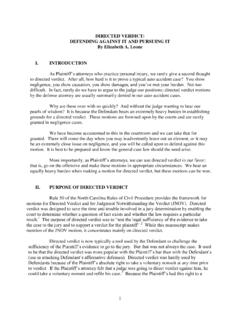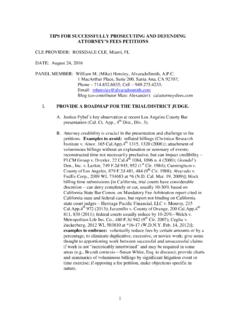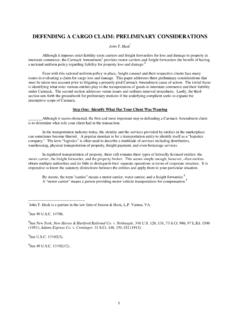Transcription of The Ego Resilience Scale - Cuyahoga County, Ohio
1 The Ego Resilience Scale Please read the below statements about yourself and indicate how well it applies to you by circling the answer to the right from 1. (does not apply at all) to 4 (applies very strongly). Let me know how true the following characteristics are as they apply to you generally: Characteristics About You Does not Apply at All Applies Very Strongly 1. I am generous with my friends. 1 2 3 4. Does not apply at Applies Applies somewhat Applies very all slightly strongly 2. I quickly get over and recover from 1 2 3 4. Does not apply at Applies Applies somewhat Applies very being startled. all slightly strongly 3. I enjoy dealing with new and unusual 1 2 3 4. Does not apply at Applies Applies somewhat Applies very situations. all slightly strongly 4. I usually succeed in making a 1 2 3 4.
2 Does not apply at Applies Applies somewhat Applies very favorable impression on people. all slightly strongly 5. I enjoy trying new foods I have never 1 2 3 4. Does not apply at Applies Applies somewhat Applies very tasted before. all slightly strongly 6. I am regarded as a very energetic 1 2 3 4. Does not apply at Applies Applies somewhat Applies very person. all slightly strongly 7. I like to take different paths to 1 2 3 4. Does not apply at Applies Applies somewhat Applies very familiar places. all slightly strongly 8. I am more curious than most people. 1 2 3 4. Does not apply at Applies Applies somewhat Applies very all slightly strongly 9. Most of the people I meet are likable. 1 2 3 4. Does not apply at Applies Applies somewhat Applies very all slightly strongly 10. I usually think carefully about 1 2 3 4.
3 Does not apply at Applies Applies somewhat Applies very something before acting. all slightly strongly 11. I like to do new and different things. 1 2 3 4. Does not apply at Applies Applies somewhat Applies very all slightly strongly 12. My daily life is full of things that 1 2 3 4. Does not apply at Applies Applies somewhat Applies very keep me interested. all slightly strongly 13. I would be willing to describe myself 1 2 3 4. Does not apply at Applies Applies somewhat Applies very as a pretty strong personality. all slightly strongly 14. I get over my anger at someone 1 2 3 4. Does not apply at Applies Applies somewhat Applies very reasonably quickly. all slightly strongly Source: (J. Block & Kremen, 1996). Scoring Interpretation Score 47-56 35-46 23-34 11-22 0-10. Level of Very High High Resiliency Undetermined Trait Low Resiliency Very Low Resilience Resiliency Trait Trait Trait Resiliency Trait The 14-Item Resilience Scale (RS-14).
4 Please read the following statements. To the right of each you will find seven numbers, ranging from "1" (Strongly Disagree) on the left to "7" (Strongly Agree) on the right. Circle the number which best indicates your feelings about that statement. For example, if you strongly disagree with a statement, circle "1". If you are neutral, circle "4", and if you strongly agree, circle "7", etc. Circle the number in the appropriate column Strongly Strongly Agree Disagree 1. I usually manage one way or another. 1 2 3 4 5 6 7. 2. I feel proud that I have accomplished things 1 2 3 4 5 6 7. in life. 3. I usually take things in stride. 1 2 3 4 5 6 7. 4. I am friends with myself. 1 2 3 4 5 6 7. 5. I feel that I can handle many things at a 1 2 3 4 5 6 7. time. 6. I am determined. 1 2 3 4 5 6 7. 7.
5 I can get through difficult times because I've 1 2 3 4 5 6 7. experienced difficulty before. 8. I have self-discipline. 1 2 3 4 5 6 7. 9. I keep interested in things. 1 2 3 4 5 6 7. 10. I can usually find something to laugh about. 1 2 3 4 5 6 7. 11. My belief in myself gets me through hard 1 2 3 4 5 6 7. times. 12. In an emergency, I'm someone people can 1 2 3 4 5 6 7. generally rely on. 13. My life has meaning. 1 2 3 4 5 6 7. 14. When I'm in a difficult situation, I can 1 2 3 4 5 6 7. usually find my way out of it. To estimate your level of Resilience (only for self evaluation), add the circled numbers: 82-98= Very High Resilience Tendencies; 64-81 High Resilience Tendencies; 49-63 = Average;. 31-48 = Low Resilience Tendencies; 14-30 = Very Low Resilience Tendencies. If you have an average score or below, talk to a colleague about those low-scoring items.
6 2009 Gail M. Wagnild and Heather M. Young. Used by permission. All rights reserved. The Resilience Scale is an international trademark of Gail M. Wagnild & Heather M. Young, 1993. Note: This form has been slightly modified for the purpose of self-assessment. This form is not intended for clinical use. Students are not being trained as clinicians, but rather to develop self-awareness of potential impact of crisis intervention work. SECONDARY TRAUMATIC STRESS Scale . The following is a list of statements made by persons who have been impacted by exposure to another person's trauma. Read each statement, then indicate how frequently the statement is true for you. NOTE: Client is used to indicate persons with whom you have been engaged in a professional context. You may substitute another noun that better represents your relationship such as client, family member, friend, co-worker.
7 Items Never Rarely Occasionally Often Very Often 1. I felt emotionally numb 1 2 3 4 5. 2. My heart started pounding when I thought 1 2 3 4 5. about my work with clients 3. It seemed as if I was reliving the trauma(s) 1 2 3 4 5. experienced by my client(s). 4. I had trouble sleeping 1 2 3 4 5. 5. I felt discouraged about the future 1 2 3 4 5. 6. Reminders of my work with clients upset me 1 2 3 4 5. 7. I had little interest in being around others 1 2 3 4 5. 8. I felt jumpy 1 2 3 4 5. 9. I was less active than usual 1 2 3 4 5. 10. I thought about my work with clients when I 1 2 3 4 5. didn't intend to 11. I had trouble concentrating 1 2 3 4 5. 12. I avoided people, places, or things that 1 2 3 4 5. reminded me of my work with clients 13. I had disturbing dreams about my work with 1 2 3 4 5.
8 Clients 14. I wanted to avoid working with some clients 1 2 3 4 5. 15. I was easily annoyed 1 2 3 4 5. 16. I expected something bad to happen 1 2 3 4 5. 17. I noticed gaps in my memory about client 1 2 3 4 5. sessions Compute Sub Scores List Scores Below Intrusion add: 2, 3, 6, 10, 13 I=. Avoidance add: 1, 5, 7, 9, 12, Av=. 14, 17. Arousal add: 4, 8, 11, 15, 16 Ar=. Total add all above Scoring is easy. First add the 1s, 2s, 3s, etc. for each of the three subscores, and then add across for each subscore. Then add together the subscores for the Total Score. Score range = 17 85. Copyright 1999 Brian E. Bri








